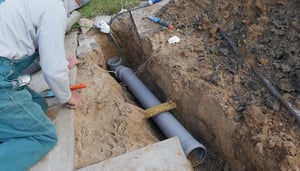What is Orangeburg Pipe? Everything You Need to Know
Posted by William Heinselman on
Sewer piping tends to be “out of sight, out of mind” until there’s, at a minimum, some sort of water backup. That’s just what happened to homeowner Erika Dronen.
 “We started having problems with our sewer line about a week after purchasing our home,” Dronen told The Patch. “Black water started coming up from the drain in our basement floor. We were told we had Orangeburg piping and the tree roots in our yard were crushing it. At this point, we have spent over $20,000 in sewer line repairs and the replacement of carpet and furniture.”
“We started having problems with our sewer line about a week after purchasing our home,” Dronen told The Patch. “Black water started coming up from the drain in our basement floor. We were told we had Orangeburg piping and the tree roots in our yard were crushing it. At this point, we have spent over $20,000 in sewer line repairs and the replacement of carpet and furniture.”
For the majority of homeowners, “Orangeburg piping” is probably an unfamiliar term. However, you owe it to yourself to be familiar with this unique form of sewer pipe because it could be a ticking time bomb beneath your feet.
What is Orangeburg Pipe?
Orangeburg pipe is a type of home sewer pipe used in many properties built from 1945 to 1972. Also known as “no-corrode” pipe, Orangeburg is a type of bituminized fiber pipe made from a mixture of hot pitch and wood pulp. It gets its name from Orangeburg, New York, where it was originally mass-produced by the Fiber Conduit Company (which later changed its name to the Orangeburg Manufacturing Company).
Although various forms of bituminized fiber pipe have been used since the 1800s, Orangeburg owes its origins to World War II, when the iron and steel commonly used for sewer pipes were critical to the war effort. Because of these shortages, Orangeburg pipe was invented so more iron and steel could go toward producing war materials. Following the war, Orangeburg continued to proliferate because it was cheap.
Once installed, standard Orangeburg sewer pipes were expected to last 50 years’ time. Unfortunately, many systems began to falter after a mere 30 years of use. Most of these structural complications resulted from the material used to manufacture the pipe. Essentially, Orangeburg pipe is little more than asphalt-soaked paper and pulp. It may seem obvious in retrospect, but if you soak paper (even tar paper) with water for long enough, it will eventually deform. Combined with the pressure from the soil above the pipe, it's not surprising these pipes began to fail so quickly.
Problems With Orangeburg Sewer Pipe
In contrast to piping made from cast iron or clay, Orangeburg pipes absorb moisture and become distorted, oftentimes in an ovular shape, under pressure. Layers of this material are also subject to bubbling up and closing the pipe off. Often described by plumbing professionals as nothing more than a “coal tar-impregnated toilet paper tube,” it’s something of a miracle that many Orangeburg pipes have lasted as long as they have.
Typically made with diameters between 2 and 18 inches, Orangeburg fell out of popularity in the early 1970s, as more reliable, efficiently produced pipe materials became available. As they were the primary option for low-cost sewer pipes until that time, Orangeburg pipe sewer systems are still featured in many older homes. For most homes built with Orangeburg, the piping has likely either already deteriorated or is on the verge of collapse. Homeowners who do not inspect and measure the deterioration of their Orangeburg systems may be faced with large-scale replacements and severe damage in time. If ignored, they could result in an extremely messy and extremely expensive sewer line collapse.
Orangeburg Pipes and Your Home
To assess the presence of Orangeburg pipes in your home, typically, homeowners need to only know the age of their home and approximate year of pipe installation. In almost any home built between the years 1945 and 1972, Orangeburg pipe systems will comprise that property’s sewage system. Additionally, landlords, real estate records and city documents will typically have this information on file.
When the deterioration of Orangeburg pipelines begins, property owners may notice the service and efficiency of their home’s sewer system and other piping change; this is the sewage system starting to fail. If this problem is left uncorrected, it can threaten the safety and health of home inhabitants.
First and foremost, if you’re buying a home that was built before 1980, have a professional plumber do an inspection to ensure there’s not Orangeburg piping (if there is, you can subtract the replacement estimate from your offer). If you’re already settled and are unsure whether you have Orangeburg piping, the previous homeowner or city documents may have the answer; if not, it’s best to bring in a professional plumber who can do an inspection for you.
Signs of Orangeburg Pipe Failure
Homeowners of properties with Orangeburg pipelines may begin to notice poor pipe flow, decreasing efficiency and other service changes over time. This gradual decline in quality, often overlooked, can develop into larger, more expensive and severe pipe collapses. By knowing common signs and indicators of deterioration, homeowners can detect pipe damage earlier and avoid major, costly renovations.
If you notice any of the following indicators of Orangeburg pipe failure, it may be time to call a professional plumbing expert in your community to assess damages:
- Frequent or persistent blockages
- Decreased flows and water pressure
- Indentations and dampness on lawns
- Lush grass concentrations
- Progressing or sudden pipe collapse
- Tree root/biological penetration into pipelines
- Frequent toilet back-ups
- Foul sewer odors inside the home
- Mold issues
- Sinkholes in the foundation
- Sudden high spikes in your monthly water bill
Each case of Orangeburg pipe systems is different. While leaks, small breaks, and deteriorated surface areas can be reinforced with trenchless technologies, a full pipe replacement with PVC piping may be necessary if the Orangeburg pipe is too far deteriorated or unsalvageable. To avoid such a costly and property-damaging scenario, it is very beneficial for homeowners to get a professional inspection of their pipe system and repair deterioration while still possible.
Orangeburg Repair Solutions
The right solution for your broken Orangeburg pipe depends on a few key factors, which change based on circumstance. Things like pipe depth, the type of break, and the severity of the break all affect what solution is best suited for your home. To evaluate pipe systems, service professionals typically use video inspection technology to determine the source of performance problems; these methods are incredibly helpful in pinpointing deteriorated areas and estimating damage severity. Once the damage has been assessed, there are a few options available for repair.
The Traditional Dig-and-Replace Method
In conventional Orangeburg pipe renovations, the damaged pipes in question would have to be manually excavated and replaced with entire new segments of pipe. While this is fine for shallow pipelines (such as those less than 1-2’ below the yard surface), it can become tricky, and pricey, with increased depth or when surface-level fixtures (driveways, sidewalks, etc.) are involved. Often, the most expensive component of traditional pipe repairs isn’t the repair itself, but the remedial landscaping tasks, lawn damage and heavy labor that is typically required.
The bottom line: dig-and-replace pipe repairs are well-suited for shallow Orangeburg pipelines, or for pipe replacements in which bursting or other non-invasive techniques could prove problematic. Traditional repairs cost anywhere from $50-250 per foot of pipe, with a project average between $4,000-13,000.
Modern Trenchless Solutions: Pipe Lining
For situations where Orangeburg pipe runs below driveways, sidewalks or other fixtures, or is fairly deep underground, dig-free pipe lining can be an affordable alternative to manual dig-and-replace repairs. Completed via application of epoxy-resin liners within existing pipe (hence the industry term, “cured-in-place pipe”), these repairs often take a matter of hours, and eliminate days, if not weeks, worth of unnecessary labor.
Trenchless technology, a method of cured-in-place pipe lining (CIPP), can effectively repair moderate pipe deterioration and damages using a fiberglass and resin Perma-liner (which molds into PVC), epoxy coating and air pressure. Today, trenchless pipe lining has become a preferred method for renovating Orangeburg pipe systems, primarily due to its seamless application and incredible efficiency.
The process is simple: A Perma-liner solution is run through damaged, targeted pipe lines, and then pressed along the existing pipe walls using an air pressure bladder. This controlled pressure forces the liner into pipe cracks, fissures and breakages, and creates virtually flawless inner walls. Ideal for Orangeburg pipe repair situations, trenchless methods can also:
- Fill entire missing segments of pipe
- Smooth pipe offsets
- Fill large cracks and seal joint connections
- Reinforce Orangeburg pipe to last for 50+ more years
- Restore cracks, root damage, and broken pipes to a new condition
CIPP lining removes stress from your existing, damaged Orangeburg pipelines and places it on the new, precisely molded PVC pipe. This vastly improves the structural integrity of your pipe system and can boost pipe life expectancy by up to 50 years. The greatest advantage of trenchless methods over other repair options, however, is its minimal effects on your property and your wallet.
Trenchless renovations do not require large-scale digging or property damage, as they are completed with existing pipelines and often use existing pipe openings. Typically, the only digging done when using trenchless technology is for two small entry and exit holes, dug at both ends of the damaged pipe. This application, also safer and ‘greener’ than full excavation replacement, can be completed in a matter of hours, often done in a single day.
It’s because of this incredible efficiency and effectiveness that trenchless technology has been embraced by homeowners and service professionals alike for Orangeburg pipe repairs. As all cases of pipe deterioration and damage are different, it is important for homeowners to accurately assess the state of their pipelines before choosing a repair method.
Pipe lining’s effectiveness depends mainly on how severe the damage is to your Orangeburg pipe. If your Orangeburg pipe is collapsed, lining won't do much to fix the problem. The pipe is still rigid enough to hold its shape and therefore the lining would make the structure strong but the flow would still be restricted. That's a solution, but not a good one. If the problem is because the pipe is collapsed, you'll have to replace the pipe.
Modern Trenchless Solutions: Pipe Bursting
If the breakage is significant or widespread throughout your pipe, another trenchless solution, pipe bursting, might be the answer. Pipe bursting is a trenchless alternative to manual pipe replacement, in situations where lining the existing pipe would not restore damages fully; this is often the case for collapsed, deteriorated Orangeburg pipe.
Using steel, conical bursting heads, which are attached to new pipes, trenchless specialists can replace your collapsed pipe entirely, without digging out the entire pipe. The cone bursting head fractures and displaces the old pipe, while simultaneously laying in place new pipe, all through small entry and exit points; this preserves both your yard and your wallet, and is the most efficient way to fully replace severely damaged pipe.
The bottom line: trenchless pipe lining can cost significantly less than dig-and-replace Orangeburg repair, as landscaping and extraneous labor tasks are largely avoided. Orangeburg pipe lining costs roughly $160 per foot, and can result in a mere $3,000 to $4,000 for small- to moderate-sized projects. Non-invasive pipe bursting costs marginally more than pipe lining, but is well worth its price tag since digging up driveways or sidewalks is avoided entirely. It’s the only way to fully replace damaged pipe without intensive digging.
Can’t Afford Orangeburg Piping Replacement?
While replacing Orangeburg piping should be a priority (remember, replacement is going to ultimately be a lot less expensive than cleaning up after a collapse), we understand that immediate replacement is not a financial option for many. Unfortunately, it’s also not often covered by insurance; if your policy does include sewer lines, chances are there is a “cap” on payouts and you’ll still be on the hook for some of the expense. You should check in with them as soon as possible.
In the meantime, have your plumber send a camera down into the sewer every six months to keep tabs on the situation. This costs money too, of course, but perhaps you can share the cost by taking turns with a neighbor or two; it’s likely they have Orangeburg piping that was installed at the same time, meaning it’s probably in similar condition. If their pipes seem to be holding up, then it’s a safe bet that yours are too, and vice versa.
If the inspection reveals damage but no imminent danger, your plumber may be able to extend the life of the pipes a bit longer by snaking them while you look into a loan or other means of affording the replacement.
Out With the Orangeburg, In With the Trenchless
Fortunately, for owners of older homes and properties, trenchless technology offers an ideal solution to the problems created by deteriorating Orangeburg sewer pipe. By eliminating the need to physically dig out your damaged pipes, you keep labor to an absolute minimum and avoid any costly, stressful landscaping renovations. This lining application is ideal for virtually any type of pipe damage, whether it’s cracking due to temperature change, fracturing at critical pipe joints or deterioration with age (often the case for Orangeburg pipe systems).
By using trenchless technology to reinforce, reline, and restore your Orangeburg sewer pipe line, homeowners can also benefit from using ‘green’ technology, which reduces risks from underground toxins and substances that can arise during conventional pipe restoration and digging.
It is no wonder why this highly efficient and effective method of pipe repair has become so prevalent today. The integration of trenchless technologies with deteriorating or damaged Orangeburg pipes is now one of the simplest and most beneficial methods of Orangeburg restoration.
While Orangeburg sewer pipe served its purpose in assisting the war effort, it's a bad idea to keep it around in its current state. Otherwise, it will just continue to collapse until it causes you a problem. If you're aware that you have Orangeburg pipe, then it will pay you to get it lined as soon as you can. For the best long-term sewer pipe care, homeowners should take an active stance to repair the aging pipes before full collapse. If you think your aging Orangeburg pipes may be starting to fail, don’t hesitate to contact a trenchless plumbing expert in your are.




